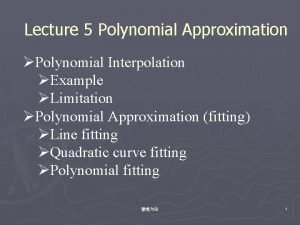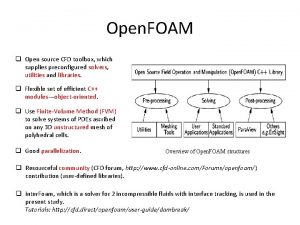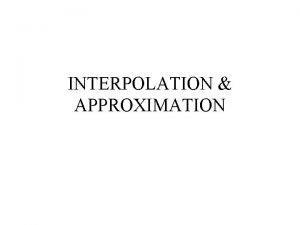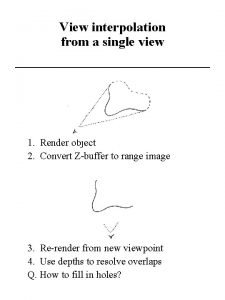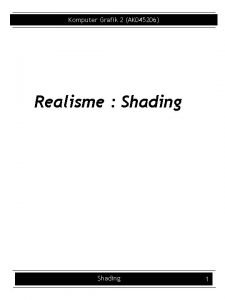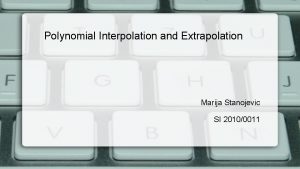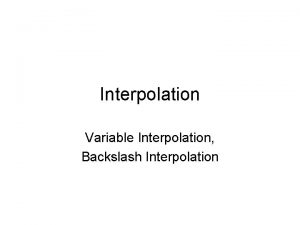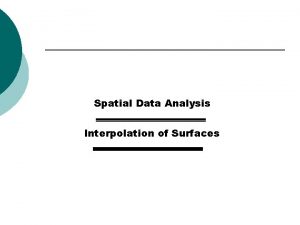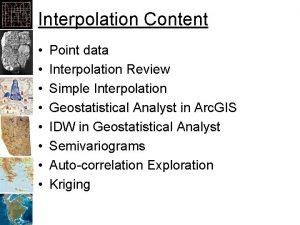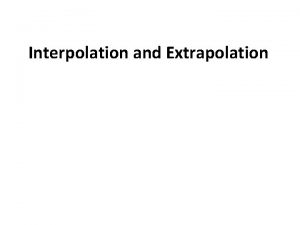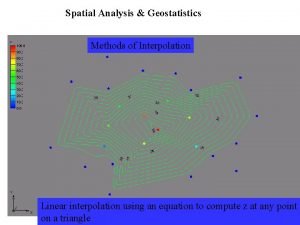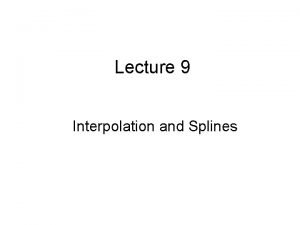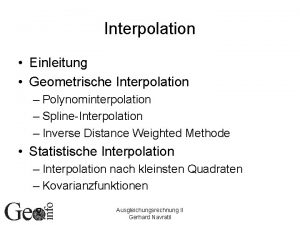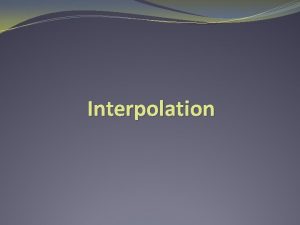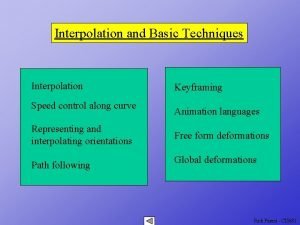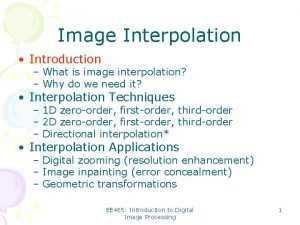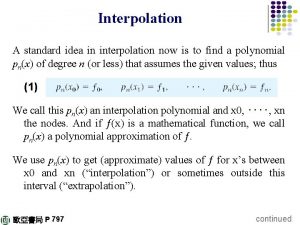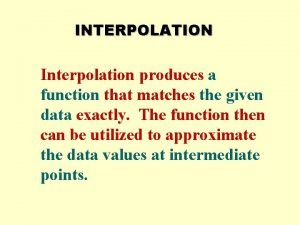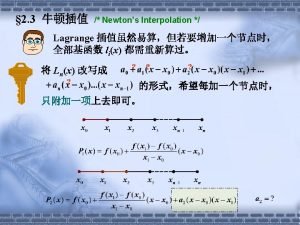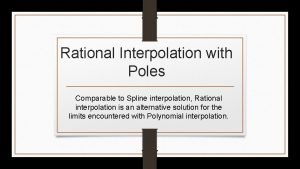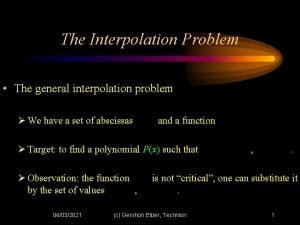Spatial Interpolation What is spatial interpolation Spatial Interpolation





















- Slides: 21

Spatial Interpolation

What is spatial interpolation? • Spatial Interpolation predicts values for cells in a raster from a limited number of sample data points. • Spatial interpolation is the process of using points with known values to estimate values of other points within a specific location.

Why Spatial Interpolation? • Usually, environmental data are collected at point locations. Interpolation is used to convert these point observations into continuous surfaces. • It can be used to predict unknown values for any geographic point data since measurements cannot be done at all locations: elevation, rainfall, temperature, chemical concentrations etc.

Interpolation • Methods differ in weighting and number of observations used • Different methods produce different results • No single method has been shown to be more accurate in every application • Accuracy is judged by withheld sample points

Known sampling locations Interpolated surface Unlike in the above example, the input data will be degraded to some extent during interpolation. Interpolation is based on the assumption that spatially distributed features are spatially correlated. things that are close together tend to have similar characteristics.

Surfaces from points Points Surface 6

Classification of Interpolation Methods – – – Different methods of interpolation are available Methods can be broadly classified as These methods again can be classified as • Deterministic / statistical • Local/ global • Exact/ approximate • Gradual/ abrupt 7

Classification: deterministic or statistical • Deterministic methods: – used when there is sufficient knowledge about the surface being modelled – allows it to be modelled as a mathematical surface • Statistical methods: – used to incorporate random variation in the interpolated surface – Difficult to execute since extra parameters are required 8

Classification: local or global • Global methods: – single mathematical function applied to all points – tends to produces smooth surfaces • Local methods: – single mathematical function applied repeatedly to subsets of the total observed points – link regional surfaces into composite surface 9

Source: http: //www. gisresources. com/

Classification: exact or approximate • Exact methods: – honour all data points. The produced surface passes exactly through all data points – appropriate for use with accurate data • Approximate methods: – do not honour all data points – more appropriate when there is high degree of uncertainty about data points 11

Exact interpolation Approximate interpolation Source: http: //www. gisresources. com/

Classification: gradual or abrupt • Gradual methods: – produce smooth surface between data points – appropriate for interpolating data of low local variability • Abrupt methods: – produce surfaces with a stepped appearance – appropriate for interpolating data of high local variability or data with discontinuities 13

Thiessen Polygons • Thiessen (Voronoi) polygons: – • assume values of unsampled locations are equal to the value of the nearest sampled point Vector-based method – – regularly spaced points produces a regular mesh irregularly spaced points produces an network of irregular polygons local, exact, abrupt and deterministic method 14

Thiessen polygon construction Source: http: //www. geog. leeds. ac. uk/ 15

Inverse Distance Weighted (IDW) • Estimates the values at unknown points using the distance and values to nearby known points (IDW reduces the contribution of a known point to the interpolated value – approximate interpolator) • The weights are proportional to the proximity of the sampled points to the unsampled location • When the point is far away from the sampled locations, the weight is less (with the distance, influence of the sampled points to the unsampled point decreases) • A larger number of sample points results in a smoother surface

Inverse Distance Weighted (IDW)

Triangulated Irregular Networks (TIN) • Vector-based method often used to create Digital Elevation/Terrain Models (DEMs/DTMs) – adjacent data points connected by lines (vertices) to create a network of irregular triangles • calculate real 3 D distance between data points along vertices using trigonometry • calculate interpolated value along facets between three vertices

Example TIN Source surface with sample points Resulting TIN Source: http: //www. geog. leeds. ac. uk/

Other methods • Krigging • Spline • Natural Neighbour…

Common problems in interpolation • Input data uncertainty – Too few data points – Limited or clustered spatial coverage – Uncertainty about location and/or value • Edge effects – Need data points outside study area – improve interpolation and avoid distortion at boundaries Week 17 GEOG 2750 – Earth Observation and GIS of the Physical Environment 21
 Spline interpolation vs polynomial interpolation
Spline interpolation vs polynomial interpolation Oflinemaps
Oflinemaps Interpolation computer science
Interpolation computer science Inverse parabolic interpolation
Inverse parabolic interpolation Peak position
Peak position Applications of matlab
Applications of matlab Swak4foam
Swak4foam Cost of equity
Cost of equity Radial basis function interpolation matlab
Radial basis function interpolation matlab Interpolation and approximation of curves in cad
Interpolation and approximation of curves in cad Civil interpolation
Civil interpolation View interpolation
View interpolation Polynomial interpolation
Polynomial interpolation Interpolation a level maths
Interpolation a level maths Interpolation formula for irr
Interpolation formula for irr Interpolation in economics
Interpolation in economics Long term decision making
Long term decision making Interpolation definition science
Interpolation definition science Extrapolation vs interpolation
Extrapolation vs interpolation Interpolation grafik
Interpolation grafik Newton interpolation java
Newton interpolation java Hec-ras cross section interpolation
Hec-ras cross section interpolation
